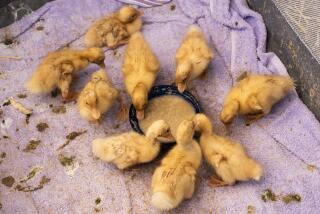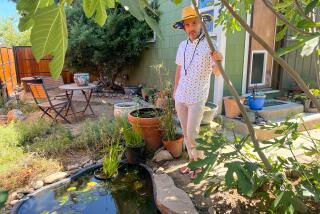Mojave’s Artificial Oasis at Risk
To see the biggest, perhaps most threatened wetlands around, follow the white pelican.
Saunter in its shadow through the alkali scrub off California 14. Let it lead you past the desert tumbleweeds and range fences until, it seems, you’ve slipped down a rabbit hole into an ecological version of the Mad Hatter’s tea party.
Life at the Piute Ponds is splendidly absurd.
So say hello to the largest group of shorebirds in Los Angeles County--in the sun-seared sand of its most landlocked expanse. Bid good day to neighbors in the ever-growing subdivisions of Lancaster, who unwittingly created this watery oasis with their sewage.
Oh, yes, meet the men in the reeds who, while blasting ducks with their shotguns and steel shot, are actually the birds’ primary protectors. And just for a second, muse about that great blue heron out there in the wavy middle distance, a giant stork of a bird, built for the marshes, nesting 25 feet above the Mojave hardpan in the spiny spires of a Joshua tree.
Few people have stumbled into the eco-loopiness of the Piute Ponds, 400 acres of artificial wetlands at Edwards Air Force Base about 60 miles north of Los Angeles. And the few who have are worried that the ponds are going to vanish under the big bleached sky without even a whimper.
“You can probably see more species of birds here than anywhere else in the county,” said Dan Cooper, a biologist for the Audubon Society. “To lose them would be a great loss.”
What may force this “ecological linchpin of the Mojave,” as Cooper calls it, into extinction is a push from base officials to stop a sanitation district from letting Piute’s treated waste water overflow into a nearby dry lake. The Air Force uses the lake bed as an emergency landing strip, and the regional water quality board, acting on the military’s request, plans to order the agency to stop the discharges.
But in this high-desert basin, where rivers flow into salty sinks instead of the ocean, waste-water disposal is a tricky business. There are aquifers to worry about and sensitive habitats to tiptoe around.
If the sanitation agency finds another dump for its excess sewage water--such as massive evaporation ponds--the wetlands could be in trouble. Without overflowing into the dry lake, officials say, the ponds would stagnate, salt would build up, and the bird waste would concentrate into a health hazard.
“So what can we do?” asked Sagar Raksit, supervising engineer for Los Angeles County Sanitation District 14. “In such small ponds with so much bird waste, you’d have botulism.”
The ponds already have some hygiene problems. The Lahontan Regional Water Quality Control Board demanded a study showing whether they were contaminating the ground water beneath them. The two ponds, surrounded by earthen berms, are not lined with plastic, but are separated from the aquifer by a thick layer of clay.
All this hubbub over the 40-year-old ponds has led bird watchers and sewage wonks to suspect that the sanctuary is being attacked. They are worried that the water-quality standards will be raised so high as to be too costly to meet.
“When an entity like the American military doesn’t want something around, it’s threatened by definition,” said Kimball Garrett, ornithology collections manager at the Los Angeles County Museum of Natural History.
But for the military’s part, a spokesman at Edwards says the Air Force is committed to saving the wetlands. “The base’s only issue is that the dry lake needs to remain dry when it naturally would be dry,” said spokesman Gary Hatch.
The Air Force says it needs Rosamond Dry Lake for emergencies and for testing. In May, a C-5 with nose gear problems landed on the cracked clay skin of Rosamond. If the lake had been wet, as parts of it often are with the effluent overflow, it could not have been used for such a maneuver.
Environmentalists have not plunged into the fray and rallied behind the cause of Piute.
Part of the lack of fervor is due to distance: The wetlands nestle up against the Kern County line. Part is political: Conservationists in the Antelope Valley are often called, in the grandiloquence of Rush Limbaugh, “environmental wackos.”
And part is access: To visit the ponds, you need written permission from the Air Force.
As in some heartland swamp, conservation is left largely to hunters.
The Antelope Valley chapter of Ducks Unlimited has invested tens of thousands of dollars in the ponds in the last decade and created a third, adjoining 150-acre pond called McKee Slough. Many of the hunters are Air Force personnel, surprised when they first learn they can grab a 12-gauge and shoot waterfowl in the desert.
“It’s one of the foremost hunting areas in the state,” said Danny Van Holton, a member of Ducks Unlimited who has been working to save Piute. “Because it’s so condensed, the birds have nowhere else to go.”
Others come simply to learn about this alien land in the Mojave.
Kristie Grubb, an elementary school teacher on the Air Force base, builds her science curriculum around the wildlife, from American white pelicans to muskrats. “It’s just phenomenal out there, just strange to see those seabirds in the desert,” she said.
Grubb is applying for grants to launch Ducks in the Desert, which would create awareness about the ponds by school kids there.
Top birders have known about the ponds for a couple of decades. Garrett, one of the county’s top ornithologists, was shocked when he stumbled on them in the late 1970s.
One day he counted more than 13,000 shorebirds, not to mention the marsh and desert birds, and wayward vagrants from as far away as the Asian coast.
“There’s no end to the surprises out there,” Garrett said.
Although the ponds are unique in many regards, shorebirds have discovered other desert sanctuaries. Places such as Mono Lake and the Salton Sea draw vast numbers of fowl as they migrate along the intricate pattern of routes collectively dubbed the Pacific Flyway. They come from the Gulf of California, the Pacific, the Gulf of Mexico, even the Arctic.
“These desert stopover sites are very important for shorebirds,” Garrett said.
Historically, birds were drawn to nearby Rosamond lake when its normally dry bed filled with rainwater each spring. The water drained out of the San Gabriel Mountains, down Amargosa Creek, through the ponds’ present location to the lake bed.
When the sewage treatment plant was built in Lancaster in 1959, it began discharging its treated effluent into the creek, which kept the lake bed wet for much more of the year.
Air Force officials didn’t like that. “One of the main reasons Edwards is even out here is these dry lakes,” said Hatch.
So the sanitation district built a dike, and the Piute Ponds were born.
Unlike Rosamond lake, the ponds remained year-round and soon began drawing birds. They existed peacefully until the 1980s, when the sanitation district wanted to divert the water to irrigate local alfalfa fields. The state Department of Fish and Game stepped in, saying that, for the birds, some water must stay in the ponds.
Now, because of growth in the valley, there is more water than the ponds and alfalfa farms can handle. Nearly 6 million gallons a day flow into the wetlands. The sanitation district is considering the construction of 30,000 acres of evaporation ponds and possibly new wetlands elsewhere. But officials say that will not solve the problems.
In the last few months, they negotiated with the regional board to buy several years more to resolve the dilemma.
“Once we stop the overflow, how are we going to save Piute?” asked the sanitation district’s Raksit.
As on most days, human sightings are the exception. The air is suffused with enough keeks and croaks and quacks to drown out the sounds from a Louisiana bayou.
Cooper, the Audubon biologist, walked along the salty levee in the midmorning glare late last month, scanning across the cattails and bull rush that line the ponds’ muddy shores. With binoculars, he quickly spotted white-faced ibises and American avocets, marsh wrens, grackles and ruddy ducks.
“Ps-ps-ps-psss,” he called out, trying to provoke the bird chorus, and adding: “You know, the Air Force really does do a good job at managing the place.”
Only the distant blue buttes and lip-cracking dry breeze gave hint that he was in the desert. Under a willow, a wren cocked its head indignantly and let out its tell-tale tat-tat-tat. On an old post in the middle of the pond, a night heron sat slope-shouldered.
A northern harrier bolted out of the reeds. Mallards honked as they flapped across the murky algal water into a virtual frame of Lewis Carroll’s imagination.
Gazing off, you could spot a vague shape in the distance: Was it a blue heron in the gangly arms of a Joshua tree? Or the pompous blue caterpillar, in wafts of hookah smoke, grumbling on his mushroom throne?
More to Read
Sign up for The Wild
We’ll help you find the best places to hike, bike and run, as well as the perfect silent spots for meditation and yoga.
You may occasionally receive promotional content from the Los Angeles Times.







